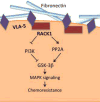Eviction from the sanctuary: Development of targeted therapy against cell adhesion molecules in acute lymphoblastic leukemia
- PMID: 28923207
- PMCID: PMC5657583
- DOI: 10.1053/j.seminoncol.2017.06.005
Eviction from the sanctuary: Development of targeted therapy against cell adhesion molecules in acute lymphoblastic leukemia
Abstract
Acute lymphoblastic leukemia (ALL) is a malignant hematological disease afflicting hematopoiesis in the bone marrow. While 80%-90% of patients diagnosed with ALL will achieve complete remission at some point during treatment, ALL is associated with high relapse rate, with a 5-year overall survival rate of 68%. The initial remission failure and the high rate of relapse can be attributed to intrinsic chemoprotective mechanisms that allow persistence of ALL cells despite therapy. These mechanisms are mediated, at least in part, through the engagement of cell adhesion molecules (CAMs) within the bone marrow microenvironment. This review assembles CAMs implicated in protection of leukemic cells from chemotherapy. Such studies are limited in ALL. Therefore, CAMs that are associated with poor outcomes or are overexpressed in ALL and have been shown to be involved in chemoprotection in other hematological cancers are also included. It is likely that these molecules play parallel roles in ALL because the CAMs identified to be a factor in ALL chemoresistance also work similarly in other hematological malignancies. We review the signaling mechanisms activated by the engagement of CAMs that provide protection from chemotherapy. Development of targeted therapies against CAMs could improve outcome and raise the overall cure rate in ALL.
Keywords: Acute lymphoblastic leukemia; Bone marrow; Cell adhesion molecules; Chemoresistance; Targeted therapy.
Copyright © 2017 Elsevier Inc. All rights reserved.
Figures






Similar articles
-
Advances in understanding the acute lymphoblastic leukemia bone marrow microenvironment: From biology to therapeutic targeting.Biochim Biophys Acta. 2016 Mar;1863(3):449-463. doi: 10.1016/j.bbamcr.2015.08.015. Epub 2015 Sep 1. Biochim Biophys Acta. 2016. PMID: 26334291 Review.
-
New insights into Notch1 regulation of the PI3K-AKT-mTOR1 signaling axis: targeted therapy of γ-secretase inhibitor resistant T-cell acute lymphoblastic leukemia.Cell Signal. 2014 Jan;26(1):149-61. doi: 10.1016/j.cellsig.2013.09.021. Epub 2013 Oct 16. Cell Signal. 2014. PMID: 24140475 Review.
-
[Research Progress on Drug-resistance of Acute Lymphoblastic Leukemia--Review].Zhongguo Shi Yan Xue Ye Xue Za Zhi. 2016 Feb;24(1):261-5. doi: 10.7534/j.issn.1009-2137.2016.01.050. Zhongguo Shi Yan Xue Ye Xue Za Zhi. 2016. PMID: 26913433 Review. Chinese.
-
Leukemia-on-a-chip: Dissecting the chemoresistance mechanisms in B cell acute lymphoblastic leukemia bone marrow niche.Sci Adv. 2020 Oct 30;6(44):eaba5536. doi: 10.1126/sciadv.aba5536. Print 2020 Oct. Sci Adv. 2020. PMID: 33127669 Free PMC article.
-
Targeting chemokines for acute lymphoblastic leukemia therapy.J Hematol Oncol. 2021 Mar 20;14(1):48. doi: 10.1186/s13045-021-01060-y. J Hematol Oncol. 2021. PMID: 33743810 Free PMC article. Review.
Cited by
-
Transcriptome Analysis Identifies LINC00152 as a Biomarker of Early Relapse and Mortality in Acute Lymphoblastic Leukemia.Genes (Basel). 2020 Mar 13;11(3):302. doi: 10.3390/genes11030302. Genes (Basel). 2020. PMID: 32183133 Free PMC article.
-
Acute lymphoblastic leukemia-derived exosome inhibits cytotoxicity of natural killer cells by TGF-β signaling pathway.3 Biotech. 2021 Jul;11(7):313. doi: 10.1007/s13205-021-02817-5. Epub 2021 Jun 4. 3 Biotech. 2021. PMID: 34109098 Free PMC article.
-
Understanding the Mechanisms by Which Epigenetic Modifiers Avert Therapy Resistance in Cancer.Front Oncol. 2020 Jun 24;10:992. doi: 10.3389/fonc.2020.00992. eCollection 2020. Front Oncol. 2020. PMID: 32670880 Free PMC article. Review.
-
Tetraspanins set the stage for bone marrow microenvironment-induced chemoprotection in hematologic malignancies.Blood Adv. 2023 Aug 22;7(16):4403-4413. doi: 10.1182/bloodadvances.2023010476. Blood Adv. 2023. PMID: 37561544 Free PMC article. Review.
-
Co-culture model of B-cell acute lymphoblastic leukemia recapitulates a transcription signature of chemotherapy-refractory minimal residual disease.Sci Rep. 2021 Aug 4;11(1):15840. doi: 10.1038/s41598-021-95039-x. Sci Rep. 2021. PMID: 34349149 Free PMC article.
References
Publication types
MeSH terms
Substances
Grants and funding
LinkOut - more resources
Full Text Sources
Other Literature Sources

